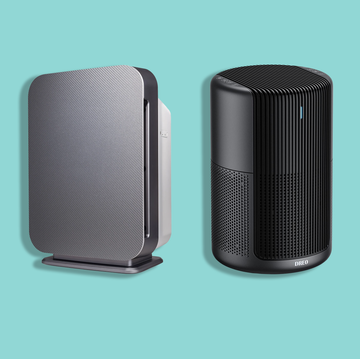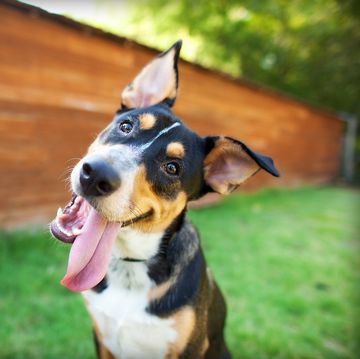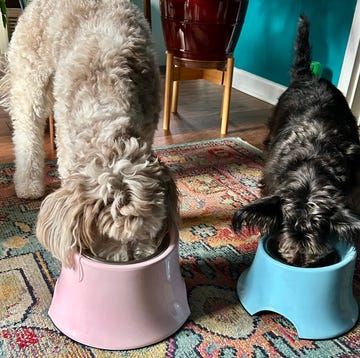It's easy to overheat in the summer — especially when you're covered in fur. Although you may know the signs of heat stroke in people, did you know that your pets can be vulnerable too? Even the healthiest dog breeds can be susceptible to overheating on a walk or in the dog park. Because our furry friends often prioritize summer fun over safety, it’s up to us to help keep them safe. Here’s how to keep your pets cool, as well as common signs your pet is sick due to overheating.
How to Keep Pets Safe
Plan Walks for Cooler Times
When it gets hot outside, strategize your walks or play sessions for early in the morning or later in the evening, when the sun isn’t at full strength.
“Some dogs don’t know when to stop exercising,” explains LaCheryl Ball, D.V.M., a veterinarian on the ASPCA Community Medicine Team. That’s why they rely on us to be their barometer. Make sure they have plenty of shade, especially if they’ll be spending a long time outside, and be mindful not to overexercise them. If your pet starts to pant excessively or seems to be slowing down, stop, bring them to a shady spot and give them some water.
Pets with flat faces such as pugs, bulldogs and Persian cats, as well as elderly and overweight pets, and those with heart and lung conditions, can’t pant as effectively to cool themselves down, so they’re even more susceptible to heatstroke. When the mercury rises, consider keeping these more delicate animals inside entirely. Even indoor pets should have access to air-conditioning or fans, especially on really hot days. Leaving the windows open can help, but make sure they have well-fitting screens, so your furry friends can’t fall out if they try to catch a breeze.
Help Prevent Burned Paws
When you do venture out, be mindful of the temperature of the sidewalk or asphalt.
“Hot pavement can burn paw pads,” says Gary Richter, D.V.M., author of The Ultimate Pet Health Guide. “If you can’t hold your palm on the pavement for five seconds, your dog shouldn’t be walking on it.”
Pets with paw-pad burns will limp and may refuse to walk; the top layer of skin on their pads might appear red, blistered and peeling. Always look for cracks and redness between your pet’s toes and on their pads, advises Ball, because those are signs that they might be getting too much exposure. Pet booties can help protect sensitive paws.
Cool Them Down Quickly
If you’re on a walk or at the park when you notice your pet getting too warm, stop and take them somewhere shady to rest and drink some water, Richter advises. Use a cloth or a towel to apply cool water to their feet, head, paws, armpits, belly, back and rump and the tops of their ears. (Don’t use ice water, as that can impact circulation and actually prevent them from cooling down, Ball notes.) Never let your pet drink from ponds, puddles or other standing water in place of bringing water along for them, since those can be sources of life-threatening illness or infection.
If you are at home or can get your pet inside, put a fan on them to facilitate evaporative cooling, which happens naturally in species that sweat more profusely, Ball says. If you have a pet with especially thick or fluffy fur, ask your vet if they’d be more comfortable with a shorter summer haircut or shave, and resist the urge to layer them up in cute outfits or T-shirts when it’s warm — if you wouldn’t wear multiple layers on a particular day, Fido probably won’t be comfortable in clothes either.
Never Leave Them in a Hot Car
It is not only extremely dangerous to leave a pet in a hot car, but also illegal in certain states, Ball says. Even with the windows cracked, the heat can rise to 20 degrees hotter than the outside temperature in just minutes, which can lead to fatal heatstroke. If you can’t bring your pet inside, leave them at home instead.
Signs of Overheating
Dogs and cats can get dehydrated easily, so always provide plenty of clean, fresh water for them to drink both inside and outside. Use a non-metal bowl outdoors, and keep it out of the sun if possible so it stays cooler. Pet fountains can help encourage picky kitties to drink.
Indications that your dog might be getting overheated include:
- Excessive panting or difficulty breathing
- Bright red or bruised gums
- Small pinpoint-type bruises on the belly or inside the ears
- Increased heart and respiratory rates
- Drooling
- Weakness
They might also seem confused or collapse. If heatstroke progresses, your pet may have seizures, vomiting or bloody diarrhea. Heatstroke can be fatal relatively quickly, so contact your vet ASAP if you notice any of these signs.
This story originally appeared in the July/August 2024 issue of Good Housekeeping. Subscribe to Good Housekeeping here.














